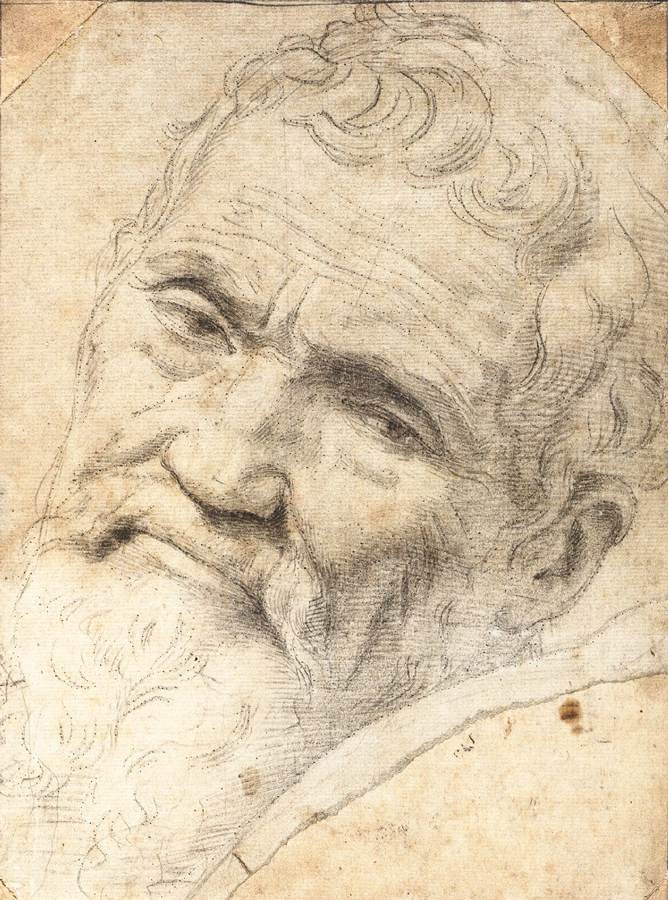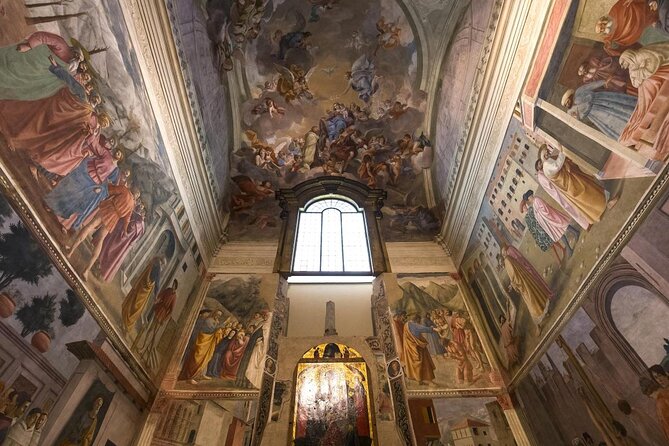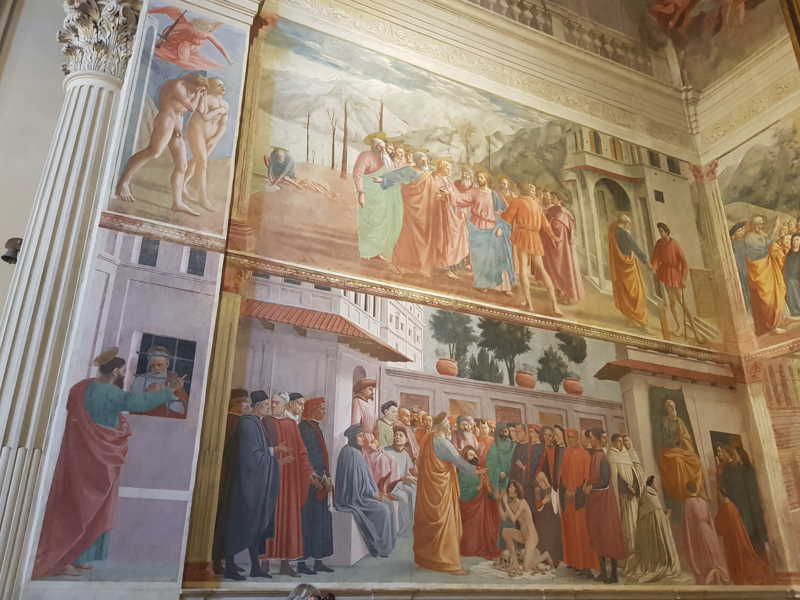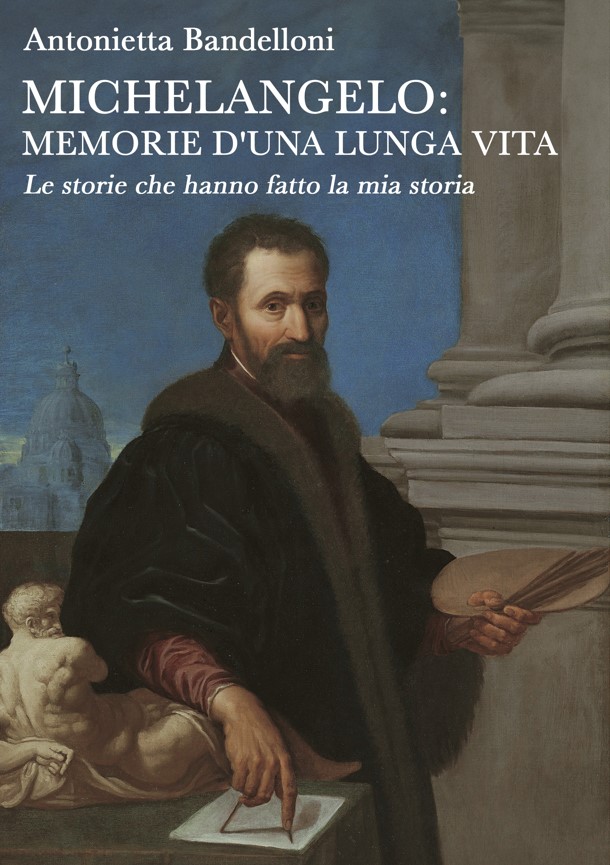La Cappella Brancacci
Bastano quaranta metri quadrati per realizzare un capolavoro?
Secondo Masolino e Masaccio sì, senza dubbio alcuno. Nella chiesa di Santa Maria del Carmine a Firenze, come scriveva il Vasari, c’è “la scuola del mondo”. Su quegli affreschi abbiamo studiato in tanti: da Leonardo da Vinci fino a Raffaello.
Anch’io poco più che bimbetto, mentre ero a bottega dai fratelli Ghirlandaio, appena potevo mi rifugiavo in questa cappella per guardare da vicino quei volti, quelle vesti e quegli atteggiamenti.
Li copiavo a carboncino su fogli di carta che riuscivo a ottenere dai miei maestri e proprio alcuni di quei disegni sono arrivati fino ai vostri giorni.
Felice Brancacci, tornato dalla spedizione fatta presso il Soldano del Cairo, volle commissionare nel 1424 la decorazione della sua cappella affidandola a Masolino da Panicale e a Masaccio, al tempo assai giovane mentre MAsolino già aveva compiuto i quarant’anni.
La cappella in questione apparteneva alla propria famiglia già alla fine del Trecento grazie all’acquisizione di Pietro di Piuviochese Brancacci.
Masolino e Masaccio si misero al lavoro decorando le tre pareti e i pilastri d’ingresso ancora oggi visibili. Purtroppo gli affreschi della volta sono andati completamente perduti nel corso dei secoli e secondo quanto narrato dal Vasari, la volta a crociera era affrescata con i quattro Evangelisti di Masolino mentre le lunette, sempre affrescate da Masolino, proponevano la vocazione di Pietro e Andrea e la Navicella.
I due artisti lavorarono a scene diverse pianificando bene il lavoro in modo tale da poter lavorare assieme senza disturbarsi a vicenda.
Qual è il tema degli affreschi?
È’ quello che viene definito come la historia salutis ovvero la storia della salvezza dell’umanità: il ciclo pittorico ha inizio con il Peccato Originale di Adamo e Eva e prosegue con le storie di San Pietro che assume il ruolo di Cristo in Terra. Dalla Genesi ai Vangeli fino agli Atti degli Apostoli.
A un certo punto i lavori vennero interrotti bruscamente. Felice Brancacci fu esiliato da Firenze nel 1436: aveva osato andare contro Cosimo I de’ Medici schierandosi apertamente col partito avversario. E’ ipotizzabile pensare che fu proprio in questo periodo nero per il Brancacci che i ritratti della famiglia inseriti nella Resurrezione del figlio di Teofilo e San Pietro in Cattedra vennero eliminati scalpellandoli via.
Ma i tempi bui non erano ancora terminati. Qualche anno dopo l’esilio venne definitivo e la cappella perse ogni riferimento possibile alla famiglia Brancacci. Vedete l’antica Madonna del Popolo che ancora oggi sta sull’altare? Fu messa lì proprio in quel periodo in occasione della ridedicazione della cappella alla medesima Madonna.
La famiglia Brancacci fu riammessa a Firenze nel 1480 e solo allora la decorazione della cappella fu portata a termine anche se oramai diverse parti erano state letteralmente eliminate. Fu Filippino Lippi a ricevere l’incarico di concludere quel capolavoro cominciato anni prima. La scelta ricadde su di lui per due motivi: non solo era un pittore molto stimato al tempo ma era figlio di Fra Filippo che era stato uno dei primi allievi di Masaccio.
Per il momento il vostro Michelangelo Buonarroti vi saluta dandovi appuntamento ai prossimi post e sui social
The Brancacci Chapel
Are forty square meters enough to create a masterpiece?
According to Masolino and Masaccio, yes, without a doubt. In the church of Santa Maria del Carmine in Florence, as Vasari wrote, there is “the school of the world”. On those frescoes we have studied many: from Leonardo da Vinci to Raphael
I too was little more than a child, while I was at the Ghirlandaio brothers’ shop, as soon as I could I took refuge in this chapel to look closely at those faces, those clothes and those attitudes.
I copied them in charcoal on sheets of paper that I could get from my masters and some of those drawings have come down to your days.
Felice Brancacci, returning from the expedition made to the Soldano of Cairo, wanted to commission the decoration of his chapel in 1424, entrusting it to Masolino da Panicale and to Masaccio, very young at the time while Masolino had already turned forty.
The chapel in question already belonged to his family at the end of the fourteenth century thanks to the acquisition of Pietro di Piuviochese Brancacci.
Masolino and Masaccio set to work decorating the three walls and the entrance pillars still visible today. Unfortunately the frescoes on the vault have been completely lost over the centuries and according to what Vasari narrated, the cross vault was frescoed with the four Evangelists of Masolino while the lunettes, always frescoed by Masolino, proposed the vocation of Peter and Andrew and the Spacecraft.
The two artists worked on different scenes planning the work well so that they could work together without disturbing each other.
What is the theme of the frescoes?
It is what is defined as the historia salutis or the history of the salvation of humanity: the pictorial cycle begins with the Original Sin of Adam and Eve and continues with the stories of St. Peter who assumes the role of Christ on Earth. From Genesis to the Gospels to the Acts of the Apostles.
At one point the work was abruptly interrupted. Felice Brancacci was exiled from Florence in 1436: he had dared to go against Cosimo I de ‘Medici by openly siding with the opposing party. It is conceivable to think that it was precisely in this black period for Brancacci that the family portraits included in the Resurrection of the son of Theophilus and St. Peter in the Chair were eliminated by chiselling them away.
But the dark times weren’t over yet. A few years later the exile was final and the chapel lost any possible reference to the Brancacci family. Do you see the ancient Madonna del Popolo which still stands on the altar today? It was placed there precisely in that period on the occasion of the rededication of the chapel to the same Madonna.
The Brancacci family was readmitted to Florence in 1480 and only then was the decoration of the chapel completed even if by now several parts had been literally eliminated. It was Filippino Lippi who was commissioned to finish that masterpiece begun years earlier. The choice fell on him for two reasons: not only was he a highly respected painter at the time but he was the son of Fra Filippo who had been one of Masaccio’s first pupils.
For the moment, your Michelangelo Buonarroti greets you by giving you an appointment at the next posts and on social networks

Sostienici – Support Us
Se questo blog ti piace e ti appassiona, puoi aiutarci a farlo crescere sempre più sostenendoci in modo concreto condividendo i post, seguendo le pagine social e con un contributo che ci aiuta ad andare avanti con il nostro lavoro di divulgazione. . ENGLISH: If you like and are passionate about this blog, you can help us make it grow more and more by supporting us in a concrete way by sharing posts, following social pages and with a contribution that helps us to move forward with our dissemination work.
5,00 €


















1 commento »